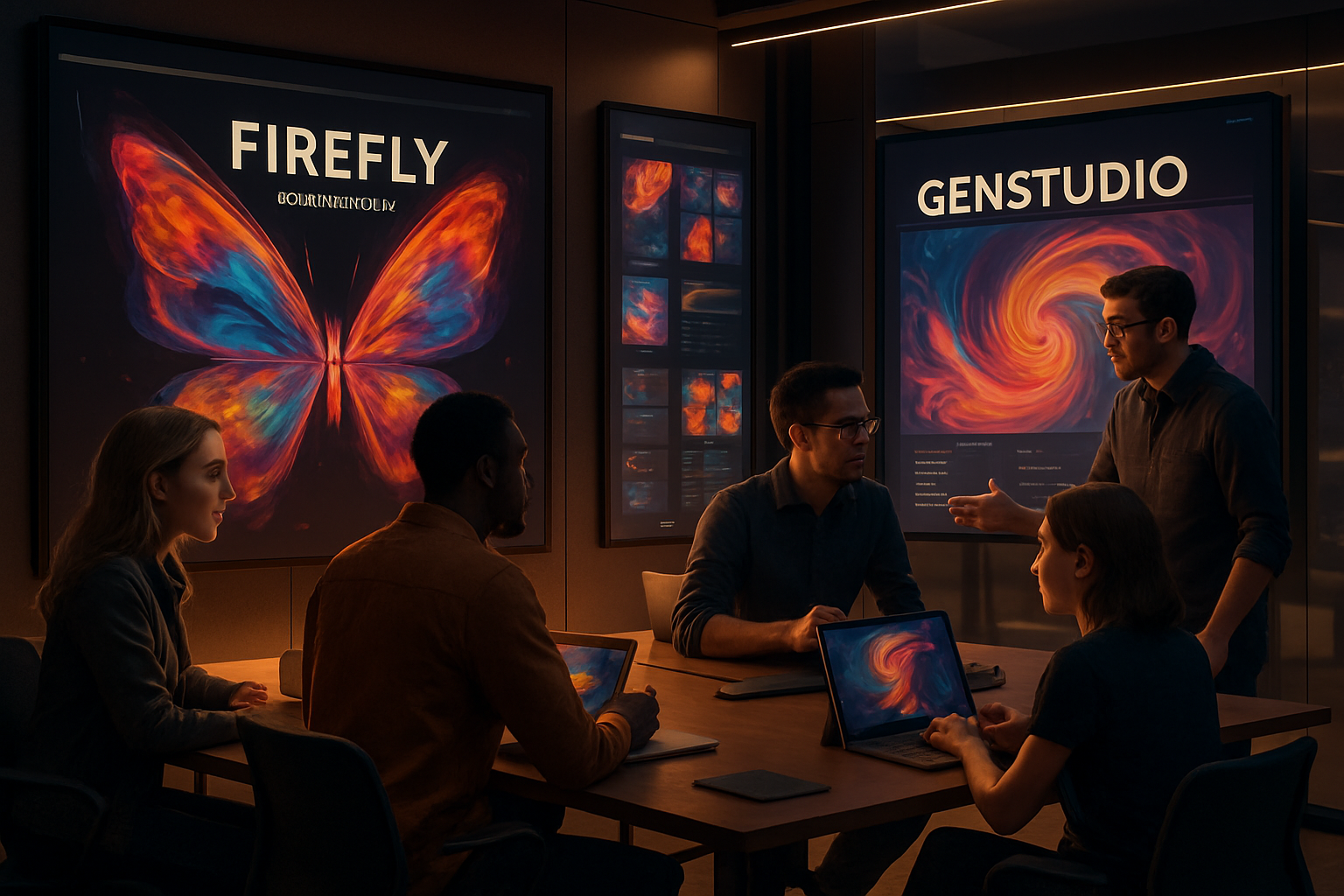
AI CERTS
2 months ago
Adobe MAX 2025: AI Design Innovation Reshapes Creative Ecosystem
Moreover, new enterprise products promise private, on-brand model customization at unprecedented scale. This strategic pivot underscores Adobe's pursuit of AI design innovation across every workflow stage. Consequently, marketers, agencies and independent artists must reassess toolchains, skills and governance models.

The following analysis unpacks key launches, partner alliances and market implications for professional readers. Throughout, we explore how AI in creative tools reshapes competitive dynamics and opportunity.
Ecosystem Redefines Creative Work
Adobe framed the ecosystem as the creative operating system for the attention economy. Firefly Image Model 5 now delivers native 4MP photorealistic outputs in public beta. Additionally, timeline AI video editing brings one-click storyboard to final cut automation.
Studio-quality audio generation rounds out cross-media capabilities. Therefore, a single interface now spans ideation, production and distribution. Analysts describe this breadth as deliberate AI design innovation anchoring Adobe's future revenue streams.
Key Launch Event Highlights
- Firefly Custom Models: private beta for brand-specific tuning across image, video and audio.
- Firefly Foundry: hands-on service building fully private models on proprietary assets.
- GenStudio upgrades: generative agents convert briefs to multi-channel campaigns, integrated ad delivery.
- AI Assistants: context-aware helpers embedded across Photoshop, Express and Firefly surfaces.
- Content Authenticity API: embed verifiable credentials at scale to fight deepfakes.
These launches signal Adobe's intent to control every creative touchpoint. However, enterprise adoption depends on trust, customization depth and performance at scale. Consequently, we next examine enterprise model traction.
Enterprise Models Gain Traction
Brands crave distinctive voices amid algorithmic noise. Firefly Foundry addresses that demand through private model training on first-party IP. Moreover, Firefly Custom Models let in-house teams self-tune without handing data to Adobe staff.
Walt Disney Imagineering and Coca-Cola publicly piloted the services during MAX demos. In contrast, earlier generative design platforms offered limited brand governance. Adobe combines Content Credentials with secured storage to meet compliance departments.
Therefore, enterprises view AI in creative tools as safer inside the familiar Adobe stack. Varun Parmar claimed GenStudio reduces production cycles by weeks for performance marketing teams. Meanwhile, 22 billion Firefly generations demonstrate real usage momentum. Such scale cements another layer of AI design innovation within enterprise roadmaps.
Private models promise speed and brand fidelity. Nevertheless, partner integrations raise important questions. We now explore those alliances.
Partner Models Expand Choice
Adobe avoided single-model dependency by integrating Google Gemini, Veo and Imagen directly. Additionally, enterprises can tune Google models through Vertex AI while staying inside Adobe workflows. Thomas Kurian highlighted seamless governance between Vertex and Firefly Foundry.
Consequently, creative teams gain aesthetic diversity without juggling multiple vendors. Open ecosystems also bolster AI in creative tools for smaller studios lacking infrastructure. However, some analysts warn about cloud concentration risk and shifting cost structures.
Adobe counters that model choice fuels AI design innovation and shields users from lock-in. Third-party players like Runway, Luma and ElevenLabs join via plugin architecture. Such breadth encourages generative design experimentation across modalities.
Moreover, every integration reinforces AI design innovation as a cross-industry standard. Partner diversity enhances creative flexibility. Yet provenance concerns linger. Authenticity tools attempt mitigation.
Authenticity And Trust Measures
Misinformation and deepfakes threaten professional reputations. Therefore, Adobe's Content Authenticity Initiative embeds tamper-evident metadata within outputs. Content Credentials carry authorship details, editing history and opt-out signals.
Additionally, a new Content Authenticity API lets enterprises automate credential attachment at scale. Nevertheless, critics argue metadata gets lost during platform reposting. Artists also question training data transparency despite AI design innovation claims.
In contrast, Adobe positions provenance as necessary infrastructure for sustainable digital creativity. Standards bodies and regulators will influence adoption velocity.
Provenance tools build confidence yet remain incomplete. Next, we assess market dynamics.
Market Forces And Risks
Generative AI spend already sits in the tens of billions according to MarketsandMarkets. Moreover, forecasts project high double-digit growth through 2030. Consequently, vendors race to capture share through differentiated features and pricing.
Adobe's integrated stack positions it against specialized generative design competitors and big-cloud platforms. However, antitrust watchers scrutinize ecosystem breadth and potential gatekeeping behavior. Job displacement also raises ethical debates as AI in creative tools automate repetitive tasks.
Furthermore, legal challenges around copyrighted training data remain unresolved. Nevertheless, many agencies see productivity gains outweighing early legal uncertainty. Analysts believe ongoing AI design innovation will depend on transparent licensing and fair revenue sharing.
Market momentum favors integrated solutions. Still, competitive and legal headwinds persist. Professionals must upskill accordingly.
Skills, Training, Next Steps
Creative leaders increasingly seek formal AI literacy pathways. Consequently, many teams evaluate certification programs to validate competence. Professionals can boost expertise through the AI+ Design™ certification.
Moreover, micro-learning modules within Creative Cloud now teach prompt engineering basics. Adobe adds contextual tutorials that activate when users launch new Firefly features. Meanwhile, agencies revise hiring criteria to include generative design portfolio samples.
Organizational success will hinge on balanced human creativity and trustworthy automation. Therefore, sustained digital creativity requires continuous learning and ethical guardrails. Leaders should track governance frameworks emerging from industry groups and regulators.
Such vigilance secures ROI on ongoing AI design innovation investments. Skills development closes talent gaps quickly. Finally, we summarize key insights.
Adobe MAX 2025 recast the company as a hub for end-to-end creative AI. Enterprise-grade customization, partner model choice and provenance tooling elevate the platform's appeal. However, legal, ethical and competitive uncertainties remain unresolved.
Nevertheless, early adoption data and marquee pilots suggest momentum is credible. Consequently, professionals should monitor AI design innovation roadmaps and evolving policy landscapes. Teams can embrace structured learning.
The AI+ Design™ certification keeps practitioners ahead of rapid changes. Ultimately, balanced experimentation will unlock the promise of AI design innovation while preserving artistry. Take decisive action, explore new tools and shape the next era of digital creativity.



